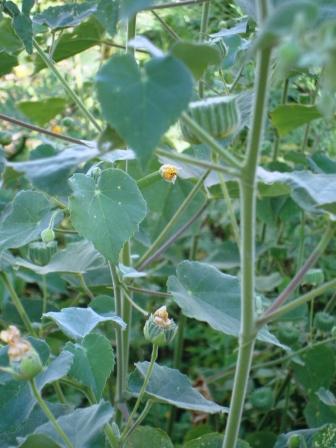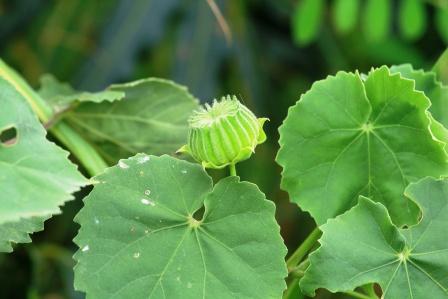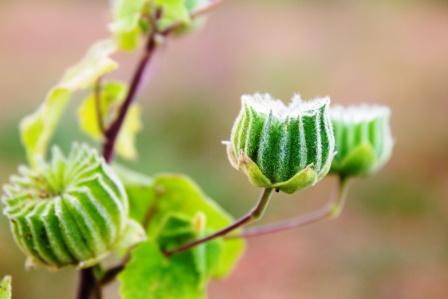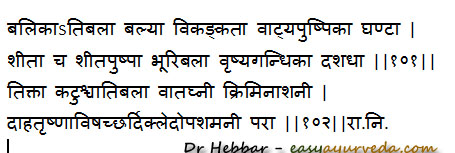Abutilon indicum – Atibala – Ayurveda Details, Usage, Health Benefits
Atibala – Abutilon indicum is an Ayurvedic herb with aphrodisiac and body strengthening properties. It is used in the treatment of leprosy, liver disorders, ulcers, headache etc. Which belongs to the family Malvaceae (Karpasa kula)
Table of Contents
Vernacular names, Sanskrit synonyms
Names in different languages:
English name: Country mallow, Indian mallow
Hindi Name – kanghi, Kakahi, ,Jhili, Atibala, Tara kanchi, Itawari
Kannada name – Tutti, Gidutingi, Urki, Hettukisu, Hetutti, Shrimudri
Telugu name – Tutturu Benda, Duvvenakaya, Duvvena Kayalu
Tamil name – Perum Tutti, Paniyara Hutti, துத்தி – thuthi, Ottututti, Kakkati, Tuttikkirai, Paniyaratutti
Bengali name – Petari, Jhapi, Potari
Marathi name – Mudra, Petari
Gujarati name – Khapat, Dabali, Kamsaki
Malayalam name – Vellula
Assamese – Japapetari, Jopa bondha
Arabian name – masthul Gola
Farsi name – Darakhtashaan
Synonyms:
Rishyaprokta – Atibala grows wild, so liked by sages and animals
Vrisya – Good Aphrodisiac
Saha – Atibala improves strength
Varshapushpika – The flowers blossom in Varsha ritu
Paterika – Friuts resembling a box
Pitapushpika – Atibala has yellow coloured flowers
Kankatika
Balika
Rishagadha
Bhuribala.

Classical categorization
Charaka – Madhura Skanda (group of herbs with sweet taste), Balya (group of herbs that impart strength.)
The herbs Bala and Atibala are together called Baladwaya
Bala, Atibala and Nagabala are together called Balatraya
Bala, Atibala, Nagabala and Mahabala are together called as Bala Chatushka.
Kaiyadeva Nighantu – Oshadhi Varga
Sodhala Nighantu, Bhavaprakasha and Dhanvantari Nighantu – Guduchyadi Varga
Raja Nighantu – Shatahvadi Varga

Morphology
Abutilon indicum is an erect grey colored velvety undershrub which grows upto 1 – 2 meters tall. Stem, leaves and branches are covered with simple minute stellate hairs. Leaves are simple, arranged alternately, ovate, base cordate in shape, margins are toothed. Flowers are bisexual, 5 petals, yellow in color. Fruit schizocarp, ovoid to subglobular in shape, brownish black when mature, dehiscent. Seeds are numerous, reniform, dark brownish in color, covered with minutely stellate hair.
Distribution
Atibala is widely distributed in the tropical and subtropical countries of America, Africa, Asia and Australia.
Varieties
In Kerala, Urena lobata is taken as a source for Atibala but most commonly, Abutilon indicum is used as Atibala.

Major chemical constituents
Hescoses, nn-alkane mixtures, alkanols, B sitasterol, Vanilllic, p-coumaric, acceic, fumaric and amino acids, alantaolactone, iso alantolactone etc
Properties, Effect on Doshas
Rasa – Madhura (sweet taste)
Guna (qualities) – Laghu (light to digest), Snigdha (unctuous, oiliness)
Vipaka – taste conversion after digestion – Madhura (sweet)
Veerya (Potency) – Cold
Effect on Tridosha – Balances Vata and Pitta.
It balances Vata and Pitta, it is absorbent, improves strength and acts as a natural aphrodisiac.
Its medicinal qualities are quite similar to those of the plant – Bala – Sida cordifolia
Shukra Vruddhikari – Increases quality and quantity of semen
Vishamajwarahara – useful against recurrent fever.
Ojovardhaka – improves immunity
Balya – tonic, improves strength
Kantivardhaka – improves skin texture and glow
Pittasrahara – relieves bleeding disorders
Kshatahara – useful in injuries
Dahahara – relieves burning sensation
Trushnahara – relieves excessive thirst
Vishahara – anti toxic, useful against poisons
Chardihara – anti emetic
It is used as a demulcent, laxative, diuretic, sedative, intestinal worm infestation,
It is also used to treat leprosy, ulcers, headaches, gonorrhea, liver disorders, jaundice and bladder infection.
Useful parts
Roots, Fruits, Seeds, Flowers, Bark
Dosage
Curna (Powder) – 1 -3 g
Uses of Different parts of Atibala
The whole plant is used as folklore medicine to treat blood dysentery, fever, allergy, piles etc. It is also used as aphrodisiac, anti‐inflammatory and has immune stimulating effect. In Siddha system of medicine atibala is used as a remedy for jaundice, piles, ulcer and leprosy.
Atibala Seeds benefits
Seeds are demulcent, laxative, expectorant and aphrodisiac; diuretic
Therapeutic indications of Seeds
Gonorrhea
Cystitis
Tinnitus
Deafness
Earaches
Fevers
Hives
Tuberculosis
Weeping ulcers
Coughs
Fevers
Bronchitis
Dysuria
Diabetes
Dysmenorrhea
Diarrhea
Boils
Skin ulcers
Puerperal disease
Urinary disorders
Chronic dysentery
Roots Benefits
Pulmonary sedative
Diuretic
Aphrodisiac
Anti- diabetic
Nervine tonic
Roots are indicated in –
Stranguary
Heamaturia
Leprosy
Stem Bark Benefits
Diuretic
Anthelmintic
Sedative
Indications of Stem bark
Fever
Due to its astringent quality it is used in Stranguary and urinary complaints.
Indications of Atibala fruit
Haemorrhagic septicemia
Piles
Gonorrhoea
Cough
Sanskrit Verses


Home Remedies
- In Fever, decoction prepared from atibala seeds and roots is used.
- Roots of Atibala, Mahabala (Sida rhombifolia Linn.), Bala and Bhumibala (Sida veronicaefolia Lam) are used to treat poisoning, diseases related to vata, pitta doshas, heart problem, eye diseases and uterine disorders.
- Atibala leaves decoction is used to treat bronchitis, bilious diarrohea, gonorrhea, bladder inflammation, urethritis and fevers.
- In toothache and painful gums decoction of atibala leaves is used as eyewash and mouthwash. It is used as a wash in gonorrhoea, ulcer and inflammation of the bladder.
- Leaves juice mixed with decoction of onion is used as best hepatoprotective. Hence this mixture is used to treat jaundice.
- Leaf juice mixed with jaggery is used as antidote in snakebite.
- To treat uterus displacement, Atibala leaf powder and wheat flour is mixed together to prepare bread. This bread is consumed daily at night for 1 month.
- Flowers of atibala are shukrala I.e it is used to increase semen in man.
- Flower paste is applied externally to treat ulcers and boils.
- Root infusion is used in fever, stranguary, heamaturia. It acts as cooling agent.
- In haemorrhagic septicemia, fruit decoction mixed with ammonium chloride is given orally.
Research
Anti diabetic activity
Anti oxidant potential
Important preparations
Atibala rasayana SS Chikitsa. 27/10 CS Chikitsa. 1/2/12
Mahanarayan Oil – A very famous Ayurvedic herbal oil for pain and rejuvenation.
Punarnavadyarishta – a traditional fermented Ayurvedic medicine
Gandha Thailam – An Oil used for faster bone healing in case of fractures and dislocations.
Side effects
There are no known side effects with this herb. Seek medical advice for its use during pregnancy.
Interaction with medicines, supplements
Can this be used while taking Homeopathic medicine?
Yes. This product does not react with homeopathic medicine.
Can
this medicine be continued while taking supplements like multivitamin tablets,
Omega 3 fatty acids etc?
Yes. Generally, this product goes well with most
of the dietary supplements. However, if you are taking more than one product
per day, please consult your doctor for an opinion.
With western medicines
Seek your doctor’s advice if you are taking this product along with other western (allopathic / modern) medicines. Some Ayurvedic herbs can interact with modern medicine.
If both Ayurvedic and allopathic medicines are advised together, then it is best to take Allopathic medicine first, wait for 30 minutes and then take the Ayurvedic medicine.
Scientific Classification
Kingdom – Plantae
Subkingdom – Tracheobionta
Super division – Spermatophyta
Division – Magnoliophyta
Class – Magnoliopsida
Subclass – Dilleniidae
Order – Malvales
Family – Malvaceae
Genus – Abutilon Mill.
Species – Abutilon indicum (L.) Sweet











4 comments
Dr JV HebbarAuthor
They are different.
Read here –
Nagabala – https://www.easyayurveda.com/2012/10/03/nagabala-full-ayurvedic-details-usage-health-benefits-formulation/
Bala – https://www.easyayurveda.com/2012/10/03/country-mallow-sida-cordifolia-ayurveda-details-health-benefits/
Vikramsimh Mandlik
कोल्हापूर, महाराष्ट्र मध्ये आम्ही या झुडुपाला जात्याचे झखड म्हणतो. आम्ही याच्या पानांचा वापर काविळीसाठी केला आहे. काविळीवर अत्यंत गुणकारी आहे. दिवसातून तीन वेळा याची एक दोन पाने खायची. कावीळ केवळ चार दिवसात बरी होते. याने माझ्या नातेवाईकाची australia antigen कावीळ १५ दिवसात बरी झाल्यावर डॉक्टरांनाही आश्चर्य वाटले.
Cyro
Which part of plant is used?
Dr J V Hebbar MD(Ayu)
Root.